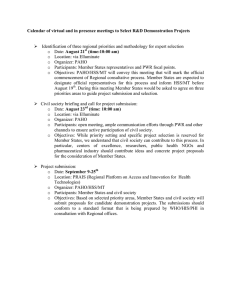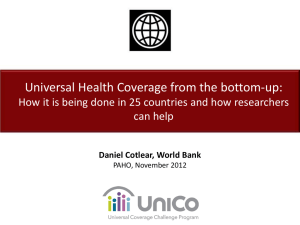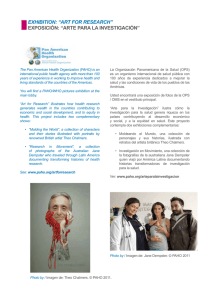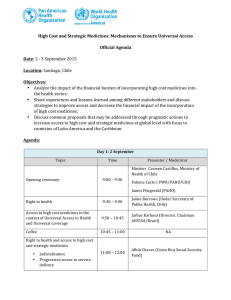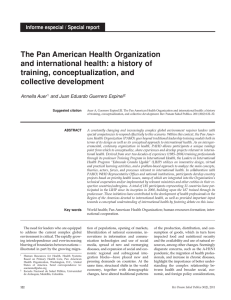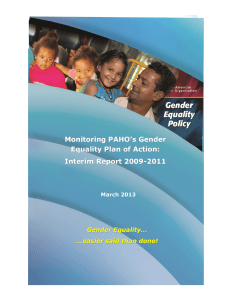Health financing for Universal Coverage
Anuncio
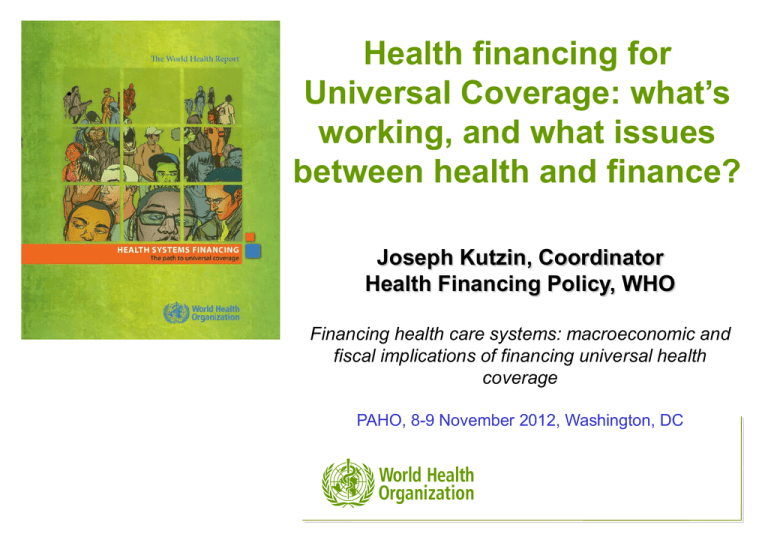
Health financing for Universal Coverage: what’s working, and what issues between health and finance? Joseph Kutzin, Coordinator Health Financing Policy, WHO Financing health care systems: macroeconomic and fiscal implications of financing universal health coverage PAHO, 8-9 November 2012, Washington, DC Overview Some general patterns in what works in health finance reforms oriented to universal coverage Some key interactions between “health” and “finance” for effective implementation of health financing reforms – With some considerations of European experience with the response to the economic and financial crisis 2| What works and doesn’t for UHC PAHO, 8-9 November 2012 UNIVERSAL COVERAGE: PROMISING DIRECTIONS, SOME POSSIBLE LESSONS 3| What works and doesn’t for UHC PAHO, 8-9 November 2012 Definition: Financing for Universal Coverage "Financing systems need to be specifically designed to: – Provide all people with access to needed health services (including prevention, promotion, treatment and rehabilitation) of sufficient quality to be effective; – Ensure that the use of these services does not expose the user to financial hardship“ – World Health Report 2010, p.6 4| What works and doesn’t for UHC PAHO, 8-9 November 2012 UHC is a direction, not a destination No country fully achieves all the coverage objectives But moving “towards UHC” is relevant to all; all want to… – Reduce the gap between need and utilization – Improve quality – Improve financial protection Often, it translates into reducing explicit inequalities in benefits and funding per capita between groups – Mexico, Thailand, South Africa using this as political driver of their reform agendas – Relatedly, UHC as a means to the end (or the embodiment) of having “fairer societies” 5| What works and doesn’t for UHC PAHO, 8-9 November 2012 Approaching health financing policy… “The path to universal coverage must be home grown” – UHC goals orient the direction of reform – Starting point is the unique arrangements of each country – National context (fiscal, administrative, political, social) conditions both what can be achieved and what can be implemented This does not mean, however, that we are open to anything – certain approaches are clearly not consistent with moving towards UHC (it’s not “anything goes”) Fortunately, some positive examples highlight promising directions 6| What works and doesn’t for UHC PAHO, 8-9 November 2012 Early 21st century pathways to UHC Thailand merged several different schemes into one, funded from general revenues, using quasi-public purchasing agency – Overcame most but not all fragmentation across schemes, and progressively working to equalize benefits across them – Increased service use while reducing catastrophic payments Mexico addressing its legacy of a fragmented and unequal system by – creating a budget-funded insurance program for a defined list of high-cost services for the entire population – creating a program of "popular insurance" for informal sector funded largely by central budget transfers to the States, which in turn are responsible for enrolling the population – Also reducing gap in per capita funding and benefits across schemes Czech Republic refined risk adjustment and made 100% of SHI revenues subject to redistribution, reducing risk selection More examples: differences in details due to differences in starting points/context Ghana and Rwanda have explicit coordination of bottomup and top-down financing mechanisms to create a virtual national pool, with general revenues as main source – Gains in utilization and financial protection Kyrgyzstan and Moldova centralized pool of budget funds, combined with new payroll tax, changed from input- to output-based payment, and increased provider autonomy – Impressive gains in geographic redistribution and efficiency Chile (through the AUGE program) and Burundi (through its PBF mechanism) link purchasing to explicit benefits – Demonstrable gains in use of defined priority services 8| What works and doesn’t for UHC PAHO, 8-9 November 2012 These countries took a “functional approach” to health financing policy Recognized that the source of funds need not determine how money was pooled, how services were purchased, nor how benefits were specified They moved away from thinking in terms of “schemes” – Pooled together or coordinated use of different revenue sources (in fact, so do Germany, Japan, Netherlands, Czech Rep, etc.) – Progressively increased the size of the compulsory prepaid funds while reducing the barriers to redistribution within it – Introduced elements of performance-related payment from the prepaid funds to address specified utilization or efficiency issues – De-linking (somewhat) health coverage from labor force status – Accompanied implementation with analysis 9| What works and doesn’t for UHC PAHO, 8-9 November 2012 That’s the “overview story” Reality is far more complex, with success requiring careful alignment of different aspects of the system with each other – hard work and no simple solutions – “Same reform” in different countries, with different effects For example in central/eastern Europe and ex-USSR – Reforms introducing compulsory health insurance associated with great progress (Estonia, Slovenia, Kyrgyzstan, Moldova) – Reforms introducing compulsory health insurance associated with great problems (Albania, Bulgaria, Kazakhstan, Russia) The devil is in the details – Which cannot be captured in a cross-country regression – Be wary of simple/simplistic solutions offered to your problems 10 | What works and doesn’t for UHC PAHO, 8-9 November 2012 Still, some general lessons Importance of public/compulsory funding Reducing fragmentation in pooling (or mitigating its consequences) 11 | What works and doesn’t for UHC PAHO, 8-9 November 2012 1. Public/compulsory funding is key Source: WHO estimates for 2010, countries with population > 600,000 No country with universal population coverage relies on voluntary health insurance as its main financing mechanism Compulsory systems work much better; no adverse selection (nor insurer response to it) Two conditions for universal coverage (Fuchs) – Subsidization (because some will be too poor or too sick to be able to afford voluntary coverage) – Compulsion (because some who can afford it are unwilling to buy it) – One without the other won’t work (subsidies alone not sufficient because rich/healthy will not join; and compulsion without subsidies impose heavy burden on the poor and sick) 13 | What works and doesn’t for UHC PAHO, 8-9 November 2012 USA: the individual insurance market is not a viable option for many people Adults ages 19–64 with individual coverage* or who tried to buy it in past three years who: Total 26 million poor nonpoor Health problem** No health problem <200% FPL 200%+ FPL Found it very difficult or impossible to find coverage they needed 43% 11 million 53% 31% 49% 35% Found it very difficult or impossible to find affordable coverage 60% 16 million 70 46 64 54 Were turned down, charged a higher price, or had condition excluded because of a preexisting condition 35% 9 million 46 20 38 34 Any of the above 71% 19 million 83 56 77 64 Note: FPL refers to Federal Poverty Level. *Bought in the past three years. **Respondent rated their health status as fair or poor, has a disability or chronic disease that keeps them from working full time or limits housework/other daily activities, or has any of the following chronic conditions: hypertension or high blood pressure; heart disease, including heart attack; diabetes; asthma, emphysema, or lung disease; high cholesterol. Source: The Commonwealth Fund Biennial Health Insurance Survey (2010). 2. Fragmentation in pooling is an obstacle to be addressed for progress towards UHC A system is fragmented when there are barriers to the redistribution of prepaid funds Fragmentation of pooling limits the ability to crosssubsidize – Can only cross-subsidize within pools, not between pools (unless there is central re-distribution mechanism) Fragmentation is a concern in virtually all health financing systems – Especially when you divide the population into different schemes with different benefits and funding levels per capita So while we want more pre-payment, we don’t want more pre-payment schemes if this means more fragmentation 15 | What works and doesn’t for UHC PAHO, 8-9 November 2012 Why pooling matters: concentration of total health expenditures, France 2001 100% 100% 90% 80% 100% 98% 90% 78% 70% 60% 64% 50% 70% 40% 30% 51% 20% 20% 10% 0% 10% 5% % of people Source : CNAMTS/EPAS (and Agnès Couffinhal) % of expenses What matters for effective risk pooling? Size – Thai Universal Coverage scheme is one pool for 47 million people, enabling universal coverage with government spending on health only accounting for about 3% of GDP Diversity – If aim is to ensure redistribution from the rich to the poor and the healthy to the sick, pool needs to include rich, poor, healthy, and sick (!!) 17 | What works and doesn’t for UHC PAHO, 8-9 November 2012 The US program for the poor is a good example of bad pooling “The problem is Medicaid is breaking right now. Medicaid is going insolvent. But more importantly, the way Medicaid works right now, most doctors don`t even take Medicaid. Every time a Medicaid patient walks into a doctor`s office, they lose money. It`s an unsustainable system and it`s ending up giving people second class health care. They’re not getting good access to good care.” - House budget committee Chairman Paul Ryan, CBS news interview, 5 April 2011 18 | What works and doesn’t for UHC PAHO, 8-9 November 2012 How do contributory systems in Europe differ from the US Medicaid approach? Like the US Medicaid program, European countries with contributory health insurance systems (e.g. Germany, Netherlands, Czech Republic, Slovakia, Switzerland) use tax revenues to subsidize coverage for those deemed too poor to pay for themselves Unlike the US, those European countries enable those subsidized to be in the same insurance pool as everyone else, spreading their risks across the whole population Unless the pooling arrangements are changed, Medicaid will always be a “poor program for the poor”, with a highrisk population relying on a financing mechanism that offers limited scope for redistribution 19 | What works and doesn’t for UHC PAHO, 8-9 November 2012 Summary of our guiding principles for health financing reform: from scheme to system Operational principles to guide progress – Explicit complementarity of different funding sources – Focus on reducing fragmentation and expanding pool size (more prepayment, not more prepayment schemes) – Recognize that real progress will require an explicit role (and often, increased levels) for general revenues – Create unified information platform across all schemes to lay foundation for universal financing system – More money and larger pools not enough: need to move towards strategic purchasing to address inefficiencies and make progress on defined, measurable objectives by linking payment to core benefits (e.g. free deliveries) 20 | What works and doesn’t for UHC PAHO, 8-9 November 2012 WHAT DOES HEALTH NEED FROM FINANCE? 21 | What works and doesn’t for UHC PAHO, 8-9 November 2012 What we need Money Responsible fiscal management to enable counter-cyclical spending Stability and predictability of revenue flows to enable effective purchasing and realization of promised benefits Aligning public sector financial management with health financing reforms, especially given importance of general revenues for real progress towards UHC Common understanding that cost containment is not the same thing as efficiency 22 | What works and doesn’t for UHC PAHO, 8-9 November 2012 What we need to give back Accountability – Transparent use of public funds – Getting results – outputs, outcomes, efficiency, equity – Public reporting Cost/expenditure management – No open-ended commitments (ex post spending well-predicted by ex ante budgets) – Responsible processes (e.g. budget impact analysis required for any package expansions) 23 | What works and doesn’t for UHC PAHO, 8-9 November 2012 1. Rationale for counter-cyclical fiscal policies for social and health expenditure Need for health care during the crisis increases Drop in public expenditure leads to an increase in private spending which in turn reduces financial protection for the poor who may forgo seeking care Utilization of services and quality of care during a crisis decrease despite increased needs Utilization decreases less where the cost of seeking care is low 24 | What works and doesn’t for UHC PAHO, 8-9 November 2012 Where the cost of seeking care is lower, the reduction of utilization is also lower “Reductions in routine care today might lead to undetected illness tomorrow and reduced individual health and wellbeing in the more distant future.”Source: Lusardi A et al. The economic crisis and medical care usage. Harvard Business School, 2010. 25 | What works and doesn’t for UHC PAHO, 8-9 November 2012 Institutional counter-cyclical arrangements helped navigating through the crisis Estonia: EHIF accumulated reserves that provided a buffer when payroll tax income drops • Save during good times, spend during bad times • But similar institutional arrangements not in place to protect the budget for public health Moldova, Lithuania & Slovakia: institutional arrangements for budget transfers • falling revenues from health insurance payroll contributions triggers increased general budget transfers • supports vulnerable groups unable to contribute financially Source of slide: Tamás Evetovits, WHO/EURO 2. Importance of aligning health financing reform and PFM systems: a Kyrgyz example Initiation of “Single Payer” reform in 2001, in 2 regions – Definition of guaranteed benefit package for entire population, including formal co-payments and exemptions – Eliminating pool fragmentation and separating purchaser from providers – Change in the purchasing methods to population and output based payment, linked explicitly to benefit package – Gradual increase of provider autonomy in management Year 1 results – Reduction of informal payments, growing awareness of benefits – Efficiency gains through massive downsizing unneeded infrastructure enables reduces fixed costs 27 | What works and doesn’t for UHC PAHO, 8-9 November 2012 The public sector management response Reforms led to both less infrastructure and more transparent reporting of patient payments But overall budget formation with MOF had not changed – Budgets still prepared according to number of beds – So 2002 budget envelope was reduced (fewer beds interpreted as "less need“, so efficiency gains were punished Success in formalizing some informal payments similarly “rewarded” – Newly visible “revenues” taken into account in budgeting, causing reduction in public finance, punishing transparency 28 | What works and doesn’t for UHC PAHO, 8-9 November 2012 3. Fiscal sustainability: a slippery concept It applies at the level of overall public spending (overall fiscal balance) At a sectoral (e.g. health) level, the concept is less clear – How much gets spent depends on a country’s overall fiscal context and the priority that government gives to each sector in its budget – So the “fiscal sustainability” of public spending on health depends in part on choice: it is not merely an external constraint 29 | What works and doesn’t for UHC PAHO, 8-9 November 2012 Level of health spending that governments choose to sustain varies widely in Europe Source: WHO estimates for 2010, countries with population > 600,000 Fiscal sustainability ≠ efficiency All systems ration, but different approaches have different implications for policy objectives Budget constraints matter, and the need for fiscal balance must be respected Increases the attention that must be paid to system efficiency: getting the most, in terms of progress on health finance policy objectives, within the constraints of available resources – Implies a need to do more than just “cut the budget”; need priorities, and reforms in how the system operates 31 | What works and doesn’t for UHC PAHO, 8-9 November 2012 Tradeoffs inevitable, but improving efficiency can lessen severity Requirement for fiscal balance Explicit rationing Price (formal copays & service exclusions) access barriers, financial burden Implicit rationing Non-price (wait lists) Price (informal payments) Non-price (service dilution, delay, denial) access barriers, dissatisfaction access barriers, financial burden, lack of transparency less health gain, reduced access, dissatisfaction, lack of transparency Source: Kutzin and Evetovits 2007 Doesn’t mean that health sector should ignore wider concerns with fiscal sustainability Health is one of the main drivers of overall public spending increases over the past few decades Fiscal authorities (national and international) have a legitimate concern that government health spending not get “out of control”, e.g. – No open-ended obligations – Budget impact analysis be required for any proposed expansion of benefits – Ex ante expenditure plans do not get undermined by ex post bailouts of loss-making public facilities 33 | What works and doesn’t for UHC PAHO, 8-9 November 2012 But need to balance and ensure we don’t lose sight of health policy objectives Sustainability is meaningless if not linked to health system objectives Financial sustainability should not be seen as a policy objective worth pursuing for its own sake If it was an objective, then a simple cost cutting exercise would do the job… …and both equity and efficiency would suffer. www.who.int/whr/2010 Thank you 35 | What works and doesn’t for UHC PAHO, 8-9 November 2012 EXTRA SLIDES 36 | What works and doesn’t for UHC PAHO, 8-9 November 2012 Accounting for government spending on health Gov’t health spending Total gov’t spending Gov’t health spending X = GDP GDP Total gov’t spending Government health spending as share of the economy Fiscal capacity Public policy priorities 37 | What works and doesn’t for UHC PAHO, 8-9 November 2012 60 It’s a choice, and health spending is the top priority for more spending across Europe Second priority 0 % of population support 20 40 First priority Health Education Source of slide: Owen Smith, World Bank Pensions Assisting poor Housing Infrastructure Environment Does UHC = Universal Health Insurance?? WHO’S APPROACH TO HEALTH FINANCING POLICY 39 | What works and doesn’t for UHC PAHO, 8-9 November 2012 Does UHC = UHI? Economists are certain that the answer is… “It depends” – More specifically, depends what we mean by “health insurance” The “insurance function” of health systems: – Access to needed care – Financial protection – German citizens are not “more insured” than British citizens, just because of the label they attach to their system or the source of funds that is used Insuring the entire population is an objective of health systems, but insurance as any specific set of institutional arrangements is not (but we know some things to avoid) 40 | What works and doesn’t for UHC PAHO, 8-9 November 2012 What kinds of choices need to be made? People Revenue collection Pooling Purchasing Service provision People and also this: This Reforms to improve how the health financing system performs Breadth, depth and scope of coverage; level and distribution of utilization, extent of catastrophic and impoverishing payments… What do we mean by “health financing policy”? Classifications or models “National Health System” (Beveridge Model) “Social Health Insurance System” (Bismarck) Old thinking, not helpful for analyzing systems and choices Functions and policies Collection Pooling Purchasing Benefits and rationing Relevant to all countries and essential for analyzing systems and choices • Understand systems (and reform options) in terms of functions, not labels or models 42 | What works and doesn’t for UHC PAHO, 8-9 November 2012 Theory and evidence have taught us a few things No country gets to UHC relying principally on voluntary health insurance – Some who can afford it won't join, and some can’t afford it – Compulsion or automatic entitlement is essential – Issue is compulsory vs voluntary, not public vs private Because there are always some who can’t contribute directly, all countries with universal population coverage rely on general budget revenues (in whole or in part) – And the larger the informal sector, the greater the need for using general revenues (but sources are not systems!) To sustain progress, need to ensure efficiency and accountability – “Strategic purchasing” as a critical strategy for this (and also for capacity strengthening, given the linkage between information and resource allocation) Principles of our approach(1): insuring the population as a core objective All financing systems (other than pure out-of-pocket) are systems of insurance – assess performance by how well they do this job, not by what they are called – WHO is committed to the objectives of health financing reform, but not to any particular institutional form or model – Similarly, our core conceptual foundations are universal. We don't have separate concepts for low, middle, and high income countries (but of course, because the starting point and other aspects of context differ, so will the relevance of different policy choices) 44 | What works and doesn’t for UHC PAHO, 8-9 November 2012 Principles(2): sources are not systems Effective policy, and policy analysis, requires thinking in terms of functions rather than models – Source of funds does not have to determine how they are pooled, how providers are paid, and how benefits and copayments are specified Labels/models… – Can be politically useful in particular contexts as a communications tool (“we are changing to an insurance system”) – But should not restrict our thinking about the choices that need to be made with respect to pooling, purchasing, benefit package, etc. 45 | What works and doesn’t for UHC PAHO, 8-9 November 2012 But…communication of this can be difficult Thinking in terms of functions may be correct, but speaking in terms of models is common and appears easier to convey for politicians and the public – “We are implementing a new social health insurance scheme” is easier than “we are reducing fragmentation in pooling”. Difficult terrain, given that many individuals and agencies are wedded to their models and frameworks Nevertheless, conceptual clarity is essential for good policy – For example, recognizing that financial protection and access can be provided from general revenues as well as “insurance contributions” 46 | What works and doesn’t for UHC PAHO, 8-9 November 2012 Communications challenges, continued Need to ensure that we communicate effectively while also thinking correctly and comprehensively – In Russia and Azerbaijan for example, it was important to say that “we are changing to an insurance system” as the means of communicating that “we need fundamental reform of our health financing system”. It did not mean a change to a fully contributory system. But also essential to avoid terminological imperialism – In any given country, what matters is the terminology that they are comfortable with and understand – WHO’s job is to ensure that, regardless of what words are used, the approach to financing reform is comprehensive and oriented to the objectives associated with universal coverage 47 | What works and doesn’t for UHC PAHO, 8-9 November 2012 WHO’s position WHO is committed to help countries sustain progress towards Universal Coverage WHO is NOT committed to any particular model – We care about access, quality and financial protection, not the label (Germans are not more “insured” than the British) WHO does NOT believe in magic – Slogans or isolated instruments do not work – “just free care” or “just SHI” or just “results-based payment” unlikely to work: the pieces need to be coordinated – Requires a comprehensive approach to address a complex, everchanging set of challenges While the goals of universal coverage are broadly shared, each country's context and starting point differs; thus, the path to universal coverage must be "home grown“ – But some approaches are clearly not consistent with UHC, and we will make clear our views, as needed, in the policy dialog process
